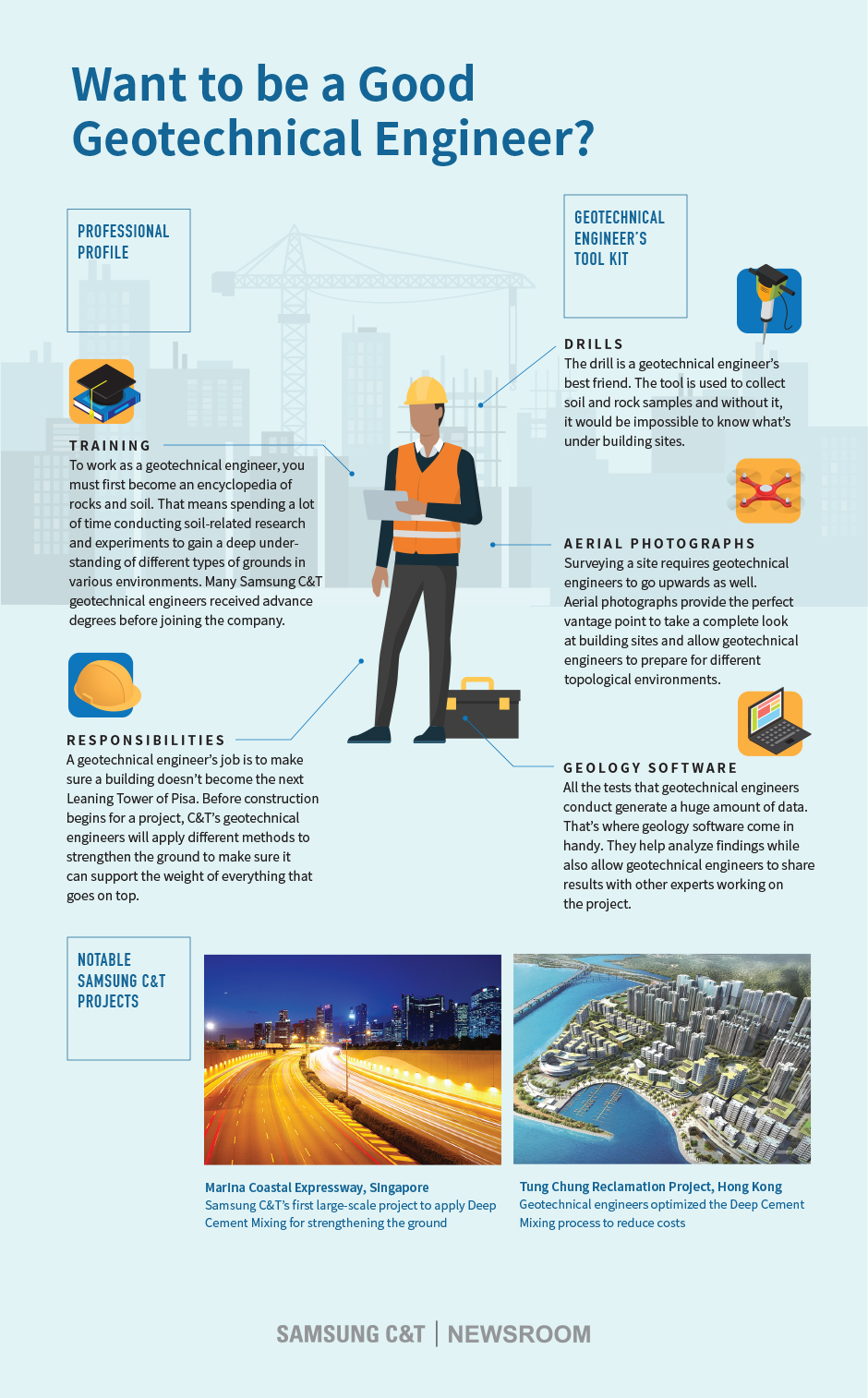8 Simple Techniques For Geotheta
8 Simple Techniques For Geotheta
Blog Article
The Buzz on Geotheta
Table of ContentsWhat Does Geotheta Mean?Geotheta Can Be Fun For AnyoneThe 7-Second Trick For GeothetaThe Only Guide for GeothetaGetting My Geotheta To Work

They carry out site examinations, gather samples, perform lab examinations, and analyze information to review the suitability of the ground for building projects - Geo Tech Engineer. Based on their searchings for, geotechnical designers supply recommendations for foundation style, slope stability, retaining structures, and mitigation of geotechnical hazards. They team up with other specialists, such as designers, architectural engineers, and construction groups, to make certain that geotechnical considerations are incorporated right into the general project layout and application
By evaluating the actions and buildings of soil and rock, they can determine possible geotechnical risks such as landslides, dirt settlement, or incline instability. Their know-how helps prevent failures or crashes that might threaten lives and property. Right here are some comprehensive responsibilities and obligations of a geotechnical designer: Site Examination: Geotechnical designers conduct site examinations to collect information on subsurface conditions.
They interpret the information to understand the homes and habits of the dirt and rock, including their stamina, permeability, compaction characteristics, and groundwater problems. Geotechnical Evaluation and Design: Geotechnical designers evaluate the information accumulated during site investigations to assess the security and suitability of the website for building and construction projects. They do geotechnical calculations and modeling to evaluate aspects such as bearing capacity, settlement, incline security, side earth stress, and groundwater circulation.
6 Simple Techniques For Geotheta
Foundation Design: Geotechnical engineers play a critical role in creating structures that can safely sustain the desired framework. They evaluate the soil conditions and tons requirements to establish the ideal structure kind, such as shallow structures (e.g., grounds), deep foundations (e.g (https://geotheta.webflow.io/)., piles), or specialized methods like soil renovation. They think about factors such as negotiation restrictions, bearing capability, and soil-structure communication to develop optimum structure layouts
They assess building plans, monitor site tasks, and perform field evaluations to validate that the design suggestions are followed. If unexpected geotechnical concerns emerge, they evaluate the scenario and provide recommendations for remediation or modifications to the layout. Risk Evaluation and Mitigation: Geotechnical designers analyze geotechnical risks and threats related to the job website, such as landslides, liquefaction, or soil erosion.

Partnership and Interaction: Geotechnical engineers work closely with other specialists included in a task, such as designers, structural engineers, and building teams. Reliable interaction and collaboration are important to integrate geotechnical considerations right into the total job style and construction procedure. Geotechnical designers give technical expertise, response inquiries, and make certain that geotechnical requirements are met.
All about Geotheta
Here are some kinds of geotechnical designers: Structure Engineer: Structure designers concentrate on developing and evaluating foundations for structures. They examine the dirt conditions, tons needs, and website characteristics to establish the most proper structure type and style, such as superficial structures, deep foundations, or specialized strategies like pile structures.
They evaluate the aspects influencing slope security, such as dirt residential properties, groundwater problems, and slope geometry, and create methods to avoid incline failures and mitigate threats. Earthquake Designer: Earthquake designers focus on assessing and designing structures to stand up to seismic pressures. They analyze the seismic threat of a site, review soil liquefaction possibility, and create seismic style criteria to make certain the safety and security and strength of frameworks throughout quakes.
They do field testing, gather examples, and evaluate the collected data to characterize the dirt homes, geologic developments, and groundwater problems at a site. Geotechnical Instrumentation Engineer: Geotechnical instrumentation designers focus on monitoring and gauging the behavior of dirt, rock, and frameworks. They install and preserve instrumentation systems that keep track of factors such as soil settlement, groundwater levels, slope movements, and structural displacements to examine performance and provide very early warnings of possible problems.
9 Easy Facts About Geotheta Described
They carry out tests such as triaxial tests, combination tests, straight shear examinations, and permeability examinations to gather data for geotechnical evaluation and style. Geosynthetics Engineer: Geosynthetics engineers specialize in the design and application of geosynthetic products, such as geotextiles, geogrids, and geomembranes. They use these materials to improve soil stability, reinforce slopes, provide drainage services, and control disintegration.
They often tend to be investigative people, which indicates they're intellectual, reflective, and analytical. They are curious, methodical, reasonable, analytical, and sensible. Some of them are additionally social, implying they're kind, generous, participating, individual, caring, useful, understanding, sensible, and friendly - Consulting Engineer.
In the office environment, geotechnical designers use specialized software application devices to carry out estimations, produce styles, and assess information. They prepare records, testimonial task specifications, interact with customers and employee, and coordinate task tasks. The office setting gives a favorable atmosphere for research study, analysis, and cooperation with various other professionals associated with the project.
Geotheta for Beginners
They regularly check out project websites to perform website examinations, analyze geotechnical problems, and collect information for analysis. These check outs include taking a trip to different areas, occasionally in remote or difficult surfaces. Geotechnical engineers might execute dirt tasting, conduct tests, and screen building and construction activities to guarantee that the geotechnical elements of the project are being carried out properly.
Geotechnical engineers also operate in specialized geotechnical labs. In these facilities, they conduct experiments, carry out tests on soil and rock samples, and analyze the engineering properties of the materials. Geotechnical laboratory engineers work thoroughly in these atmospheres, managing screening devices, running tools, and videotaping data. They team up with other lab staff to guarantee precise and reliable screening results.
Report this page